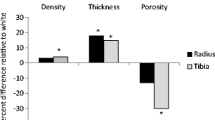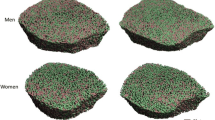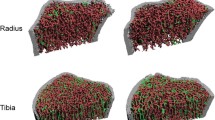Abstract
Summary
This study used extreme phenotype selection to define two trabecular bone phenotypes in a cohort of Chinese-American and Caucasian women. A trabecular plate-predominant phenotype is more common in Chinese-Americans while the rod-predominant phenotype is more typical of Caucasians. The robustness of these phenotypic associations with respect to lifestyle factors suggests that this trait may have a genetic basis and that these phenotypes can be utilized in future genetic studies.
Introduction
Compared to Caucasians, Chinese-Americans have more plate-like trabecular bone when measured by individual trabecula segmentation (ITS). These findings suggest a phenotypic difference between the races, which may be amenable to genetic analysis. We sought to identify a single ITS plate trait to pursue in genetic studies by conducting an extreme phenotype selection strategy to numerically define two distinct phenotypes—plate-like and rod-like—and determine whether the selected phenotypic associations were independent of lifestyle factors in order to conduct future genetic studies.
Methods
A previously described cohort of 146 Chinese-American and Caucasian women with high-resolution peripheral quantitative computed tomography imaging and ITS analyses were studied with logistic regression and receiver operator characteristic analyses.
Results
The tibial plate-to-rod (TPR) ratio was the best ITS discriminator of race. Using extreme phenotypic selection, two TPR ratio phenotypes were defined numerically: plate-like as a TPR ratio value in the highest quartile (≥1.336) and rod-like as a TPR ratio value in the lowest quartile (≤0.621). Women with a plate-like phenotype were 25.7 times more likely (95 % CI 7.3–90.1) to be Chinese-American than women with rod-like morphology. After controlling for constitutional and lifestyle covariates, women in the highest vs. lowest TPR ratio quartile were 85.0 times more likely (95 % CI 12.7–568.0) to be Chinese-American.
Conclusion
Using extreme phenotype selection, we defined a plate- and rod-like trabecular bone phenotype for the TPR ratio trait. The former phenotype is more common in Chinese-American women, while the latter is more typical of Caucasian women. The robustness of these phenotypic associations after controlling for differences in constitution and lifestyle suggest that the TPR ratio may have a genetic basis and that the extreme phenotypes defined in this analysis can be utilized for future studies.

Similar content being viewed by others
References
Barrett-Connor E, Siris ES, Wehren LE, Miller PD, Abbott TA, Berger ML, Santora AC, Sherwood LM (2005) Osteoporosis and fracture risk in women of different ethnic groups. J Bone Miner Res 20:185–194
Walker MD, Babbar R, Opotowsky AR et al (2006) A referent bone mineral density database for Chinese American women. Osteoporos Int 17:878–887
Woo J, Li M, Lau E (2001) Population bone mineral density measurements for Chinese women and men in Hong Kong. Osteoporos Int 12:289–295
Xiaoge D, Eryuan L, Xianping W, Zhiguang Z, Gan H, Zaijing J, Xiaoli P, Hongzhuan T, Hanwen W (2000) Bone mineral density differences at the femoral neck and Ward's triangle: a comparison study on the reference data between Chinese and Caucasian women. Calcif Tissue Int 67:195–198
Russell-Aulet M, Wang J, Thornton JC, Colt EW, Pierson RN Jr (1993) Bone mineral density and mass in a cross-sectional study of White and Asian women. J Bone Miner Res 8:575–582
Lauderdale DS, Jacobsen SJ, Furner SE, Levy PS, Brody JA, Goldberg J (1997) Hip fracture incidence among elderly Asian-American populations. Am J Epidemiol 146:502–509
Xu L, Lu A, Zhao X, Chen X, Cummings SR (1996) Very low rates of hip fracture in Beijing, People's Republic of China the Beijing Osteoporosis Project. Am J Epidemiol 144:901–907
Wang XF, Wang Q, Ghasem-Zadeh A, Evans A, McLeod C, Iuliano-Burns S, Seeman E (2009) Differences in macro- and microarchitecture of the appendicular skeleton in young Chinese and White women. J Bone Miner Res 24:1946–1952
Liu XS, Walker MD, McMahon DJ, Udesky J, Liu G, Bilezikian JP, Guo XE (2011) Better skeletal microstructure confers greater mechanical advantages in Chinese-American women versus White women. J Bone Miner Res 26:1783–1792
Finkelstein JS, Lee ML, Sowers M, Ettinger B, Neer RM, Kelsey JL, Cauley JA, Huang MH, Greendale GA (2002) Ethnic variation in bone density in premenopausal and early perimenopausal women: effects of anthropometric and lifestyle factors. J Clin Endocrinol Metab 87:3057–3067
Marshall LM, Zmuda JM, Chan BK, Barrett-Connor E, Cauley JA, Ensrud KE, Lang TF, Orwoll ES (2008) Race and ethnic variation in proximal femur structure and BMD among older men. J Bone Miner Res 23:121–130
Walker MD, Liu XS, Stein E et al (2011) Differences in bone microarchitecture between postmenopausal Chinese-American and White women. J Bone Miner Res 26:1392–1398
Walker MD, McMahon DJ, Udesky J, Liu G, Bilezikian JP (2009) Application of high-resolution skeletal imaging to measurements of volumetric BMD and skeletal microarchitecture in Chinese-American and White women: explanation of a paradox. J Bone Miner Res 24:1953–1959
Walker MD, Saeed I, McMahon DJ, Udesky J, Liu G, Lang T, Bilezikian JP (2012) Volumetric bone mineral density at the spine and hip in Chinese American and White women. Osteoporos Int 23:2499–2506
Sornay-Rendu E, Cabrera-Bravo JL, Boutroy S, Munoz F, Delmas PD (2009) Severity of vertebral fractures is associated with alterations of cortical architecture in postmenopausal women. J Bone Miner Res 24:737–743
Sornay-Rendu E, Boutroy S, Munoz F, Delmas PD (2007) Alterations of cortical and trabecular architecture are associated with fractures in postmenopausal women, partially independent of decreased BMD measured by DXA: the OFELY study. J Bone Miner Res 22:425–433
Walker MD, Cong E (2014) The Chinese skeleton: insights into microstructure that help to explain the epidemiology of fracture. Bone Research 2:14009
Walker MD, Liu XS, Zhou B, Agarwal S, Liu G, McMahon DJ, Bilezikian JP, Guo XE (2013) Pre- and postmenopausal differences in bone microstructure and mechanical competence in Chinese-American and White women. J Bone Miner Res. 28(6):1308--1318
Zhou B, Sherry Liu X, Wang J, Lucas Lu X, Fields AJ, Edward Guo X (2014) Dependence of mechanical properties of trabecular bone on plate-rod microstructure determined by individual trabecula segmentation (ITS). J Biomech 47:702–708
Liu XS, Sajda P, Saha PK, Wehrli FW, Bevill G, Keaveny TM, Guo XE (2008) Complete volumetric decomposition of individual trabecular plates and rods and its morphological correlations with anisotropic elastic moduli in human trabecular bone. J Bone Miner Res 23:223–235
Liu XS, Stein EM, Zhou B et al (2012) Individual trabecula segmentation (ITS)-based morphological analyses and microfinite element analysis of HR-pQCT images discriminate postmenopausal fragility fractures independent of DXA measurements. J Bone Miner Res 27:263–272
Liu XS, Cohen A, Shane E et al (2010) Individual trabeculae segmentation (ITS)-based morphological analysis of high-resolution peripheral quantitative computed tomography images detects abnormal trabecular plate and rod microarchitecture in premenopausal women with idiopathic osteoporosis. J Bone Miner Res 25:1496–1505
Guey LT, Kravic J, Melander O et al (2011) Power in the phenotypic extremes: a simulation study of power in discovery and replication of rare variants. Genet Epidemiol. doi:10.1002/gepi.20572
Perez-Gracia JL, Gurpide A, Ruiz-Ilundain MG, Alfaro Alegria C, Colomer R, Garcia-Foncillas J, Melero Bermejo I (2010) Selection of extreme phenotypes: the role of clinical observation in translational research. Clin Transl Oncol 12:174–180
Barnett IJ, Lee S, Lin X (2013) Detecting rare variant effects using extreme phenotype sampling in sequencing association studies. Genet Epidemiol 37:142–151
Cohen JC, Kiss RS, Pertsemlidis A, Marcel YL, McPherson R, Hobbs HH (2004) Multiple rare alleles contribute to low plasma levels of HDL cholesterol. Science 305:869–872
Hertzler A, Frary R (1994) A dietary rapid assessment method (RAM). Top Clin Nutr 9:76–85
Herrmann M, Harwood T, Gaston-Parry O, Kouzios D, Wong T, Lih A, Jimenez M, Janu M, Seibel MJ (2010) A new quantitative LC tandem mass spectrometry assay for serum 25-hydroxy vitamin D. Steroids 75:1106–1112
Nussbaum SR, Zahradnik RJ, Lavigne JR, Brennan GL, Nozawa-Ung K, Kim LY, Keutmann HT, Wang CA, Potts JT Jr, Segre GV (1987) Highly sensitive two-site immunoradiometric assay of parathyrin, and its clinical utility in evaluating patients with hypercalcemia. Clin Chem 33:1364–1367
Bonnick SL, Johnston CC Jr, Kleerekoper M, Lindsay R, Miller P, Sherwood L, Siris E (2001) Importance of precision in bone density measurements. J Clin Densitom 4:105–110
Boutroy S, Bouxsein ML, Munoz F, Delmas PD (2005) In vivo assessment of trabecular bone microarchitecture by high-resolution peripheral quantitative computed tomography. J Clin Endocrinol Metab 90:6508–6515
Boutroy S, van Rietbergen B, Sornay-Rendu E, Munoz F, Bouxsein ML, Delmas PD (2008) Finite element analyses based on in vivo HR-pQCT images of the distal radius is associated with wrist fracture in postmenopausal women. J Bone Miner Res 23:392–399
Cohen A, Liu XS, Stein EM, McMahon DJ, Rogers HF, Lemaster J, Recker RR, Lappe JM, Guo XE, Shane E (2009) Bone microarchitecture and stiffness in premenopausal women with idiopathic osteoporosis. J Clin Endocrinol Metab 94:4351–4360
Stein EM, Liu XS, Nickolas TL et al (2010) Abnormal microarchitecture and reduced stiffness at the radius and tibia in postmenopausal women with fractures. J Bone Miner Res 25:2572–2581
Liu XS, Zhang XH, Sekhon KK, Adams MF, McMahon DJ, Bilezikian JP, Shane E, Guo XE (2010) High-resolution peripheral quantitative computed tomography can assess microstructural and mechanical properties of human distal tibial bone. J Bone Miner Res 25:746–756
Saha PK, Chaudhuri BB, Majumder DD (1997) A new shape preserving parallel thinning algorithm for 3D digital images. Pattern Recogn 30:1939–1955
Saha PK, Chaudhuri BB (1994) Detection of 3-D simple points for topology preserving. IEEE Trans Pattern Anal Mach Intell 16:1028–1032
Saha PK, Chaudhuri BB, Chanda B, Dutta Majumder D (1994) Topology preservation in 3D digital space. Pattern Recogn 27:295–300
Saha PK, Chaudhuri BB (1996) 3D digital topology under binary transformation with applications. Comput Vis Image Underst 63:418–429
Liu XS, Sajda P, Saha PK, Wehrli FW, Guo XE (2006) Quantification of the roles of trabecular microarchitecture and trabecular type in determining the elastic modulus of human trabecular bone. J Bone Miner Res 21:1608–1617
Tang H, Quertermous T, Rodriguez B et al (2005) Genetic structure, self-identified race/ethnicity, and confounding in case–control association studies. Am J Hum Genet 76:268–275
Flicker L, Hopper JL, Rodgers L, Kaymakci B, Green RM, Wark JD (1995) Bone density determinants in elderly women: a twin study. J Bone Miner Res 10:1607–1613
Dequeker J, Nijs J, Verstraeten A, Geusens P, Gevers G (1987) Genetic determinants of bone mineral content at the spine and radius: a twin study. Bone 8:207–209
Pocock NA, Eisman JA, Hopper JL, Yeates MG, Sambrook PN, Eberl S (1987) Genetic determinants of bone mass in adults. A twin study. J Clin Invest 80:706–710
Slemenda CW, Christian JC, Williams CJ, Norton JA, Johnston CC Jr (1991) Genetic determinants of bone mass in adult women: a reevaluation of the twin model and the potential importance of gene interaction on heritability estimates. J Bone Miner Res 6:561–567
Hsu YH, Kiel DP (2012) Clinical review: Genome-wide association studies of skeletal phenotypes: what we have learned and where we are headed. J Clin Endocrinol Metab 97:E1958–E1977
Paternoster L, Lorentzon M, Lehtimaki T et al (2013) Genetic determinants of trabecular and cortical volumetric bone mineral densities and bone microstructure. PLoS Genet 9:e1003247
Kim S, Macdonald HM, Nettlefold L, McKay HA (2013) A comparison of bone quality at the distal radius between Asian and White adolescents and young adults: an HR-pQCT study. J Bone Miner Res 28:2035–2042
Acknowledgments
This work was supported by NIH grants K23 AR053507 as well as AR051376, a National Osteoporosis Foundation grant, and the Mary and David Hoar Fellowship Program of the New York Community Trust and the New York Academy of Medicine. We thank Dr. Clyde Wu for his vision and support of this study.
Conflicts of interest
None
Author information
Authors and Affiliations
Corresponding author
Rights and permissions
About this article
Cite this article
Walker, M.D., Shi, S., Russo, J.J. et al. A trabecular plate-like phenotype is overrepresented in Chinese-American versus Caucasian women. Osteoporos Int 25, 2787–2795 (2014). https://doi.org/10.1007/s00198-014-2816-0
Received:
Accepted:
Published:
Issue Date:
DOI: https://doi.org/10.1007/s00198-014-2816-0




